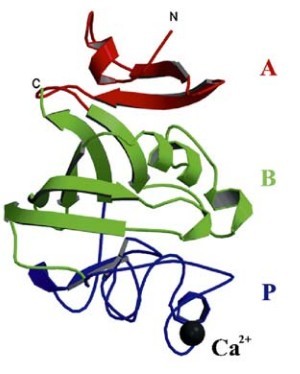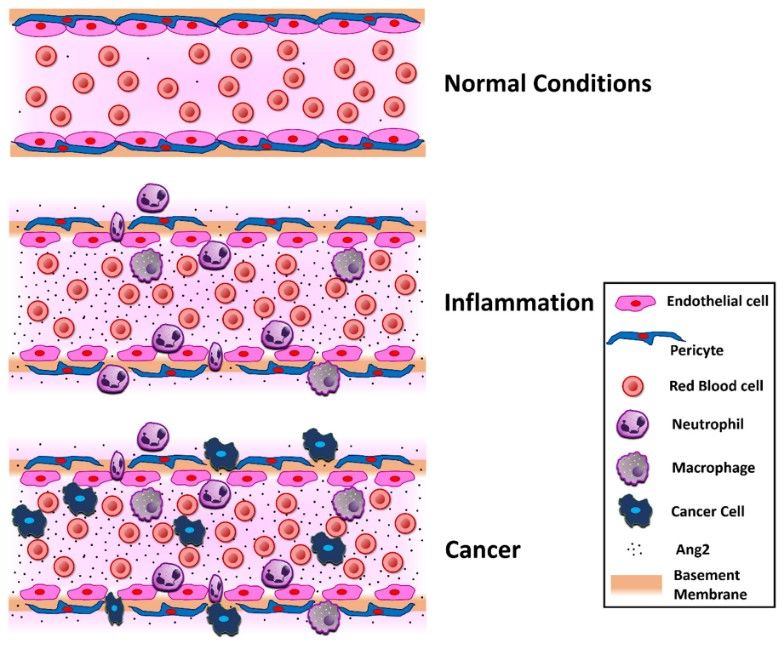| Catalog# | Product Name | Size | Price | Qty | Inquiry |
|---|---|---|---|---|---|
| THP-0308 | Trebananib | 1 vial | $2,998.00 |
|
Add to Cart Order |
Angiopoietin 2 (Ang2), encoded by the gene ANGPT2, is a key regulator of vascular remodeling, angiogenesis and inflammation. The angiopoietin-Tie2 axis plays a central role in vascular biology. Ang2, a secreted glycoprotein, competes with its counterpart angiopoietin 1 (Ang1, encoded by the gene ANGPT1) for binding to the Tie2 receptor. In contrast to Ang1, which stabilizes the vasculature, Ang2 promotes vascular destabilization, angiogenesis and inflammation. Dysregulated Ang2 expression is associated with pathological angiogenesis and endothelial dysfunction, making it a critical target for therapeutic intervention.
NCBI Gene ID: 285
UniProtKB ID: O15123
Angiopoietin 2 protein is composed of an N-terminal supercluster domain, a central coiled-coil domain, a linker region, and a C-terminal fibrinogen-like domain that is primarily responsible for binding to its receptor, Tie2; it shares an essentially similar structure with other angiopoietins, but has distinct functional properties due to its unique sequence variations.
Key points about Ang2 structure:
 Figure 1. Structure of Ang2 fibrinogen-like
receptor binding domain (RBD). The refined model of Ang2-RBD with each of the three domains shown in a different color. The black sphere represents the
bound calcium ion. (Barton et al., 2015)
Figure 1. Structure of Ang2 fibrinogen-like
receptor binding domain (RBD). The refined model of Ang2-RBD with each of the three domains shown in a different color. The black sphere represents the
bound calcium ion. (Barton et al., 2015)
Ang2 is primarily stored in Weibel-Palade bodies in endothelial cells and is rapidly released in response to various stimuli, including hypoxia, inflammation, and mechanical stress. Its expression is tightly regulated at both transcriptional and post-transcriptional levels, with hypoxia-inducible factor-1α (HIF-1α) being a key transcriptional regulator.
The role of Ang2 in blood endothelial cells (BECs) remains complex and context-dependent. Under physiological conditions, Ang2 functions primarily as an antagonist of angiopoietin 1 by inhibiting Tie2 phosphorylation. Ang1 is known to rapidly auto phosphorylate the Tie2 receptor in endothelial cells, thereby stabilizing the vasculature and preventing excessive angiogenesis. However, Ang2 counteracts this effect by binding to Tie2 without inducing full phosphorylation, leading to endothelial destabilization and increased vascular permeability.
However, recent research suggests that Ang2 may also act as a Tie2 agonist under certain conditions. The presence of Tie1, a co-receptor, plays a critical role in determining whether Ang2 functions as an agonist or antagonist. In inflamed endothelium, Tie1 cleavage shifts Ang2 from an agonistic to an antagonistic role. This phenomenon is supported by studies in Tie1-deficient mice in which Ang2 loses its agonistic activity.
In lymphatic endothelial cells (LECs), Ang2 acts predominantly as an agonist rather than an antagonist. High concentrations of Ang2 induce Tie2 phosphorylation, which promotes LEC proliferation and survival. The observed angiogenic and anti-apoptotic effects of Ang2 in LECs are attributed to the reduced expression of Tie1, which otherwise inhibits Ang2-induced Tie2 activation. Compared to BECs, LECs have lower levels of Tie1, allowing a more agonistic role for Ang2.
In addition, the absence of vascular endothelial protein tyrosine phosphatase (VE-PTP) in LECs further modulates Ang2 function. VE-PTP has been identified as a key regulator of the agonistic and antagonistic roles of Ang2 in blood endothelial cells. Studies have shown that inhibition of VE-PTP converts Ang2 into a potent Tie2 activator, highlighting the context-dependent nature of Ang2 signaling.
Dysregulated Ang2 contributes to a wide range of pathological conditions:
 Figure 2. Schematic representation of the Ang2
effect on the vascular bed in normal conditions, inflammation, and cancer. Under normal physiological conditions, Ang2 levels are low, but are upregulated
during inflammation or cancer. Ang2 acts on endothelial cells, increasing endothelial permeability and also on the pericytes, causing pericyte detachment
from the basement membrane, further inducing vascular leakiness, immune or/and cancer cell trans-endothelial migration, and deterioration of the condition.
Ang2 has been proposed as a marker for inflammatory conditions and cancer. (Akwii et al., 2019)
Figure 2. Schematic representation of the Ang2
effect on the vascular bed in normal conditions, inflammation, and cancer. Under normal physiological conditions, Ang2 levels are low, but are upregulated
during inflammation or cancer. Ang2 acts on endothelial cells, increasing endothelial permeability and also on the pericytes, causing pericyte detachment
from the basement membrane, further inducing vascular leakiness, immune or/and cancer cell trans-endothelial migration, and deterioration of the condition.
Ang2 has been proposed as a marker for inflammatory conditions and cancer. (Akwii et al., 2019)
Given its pathological role, Ang2 is an attractive target for therapeutic intervention. Several approaches have been developed to inhibit Ang2 activity and restore vascular stability.
Therapeutic targeting of Ang2 has broad applications in oncology, inflammatory diseases, and vascular leakage syndromes. However, challenges remain:
Creative BioMart provides high-quality therapeutic proteins, explore our comprehensive product categories. For questions or inquiries, please contact us.
References
For more information on how our products could help advance your project, please contact us.
ENTER YOUR EMAIL HERE TO SUBSCRIBE.
Copyright © 2025 Creative BioMart. All Rights Reserved.